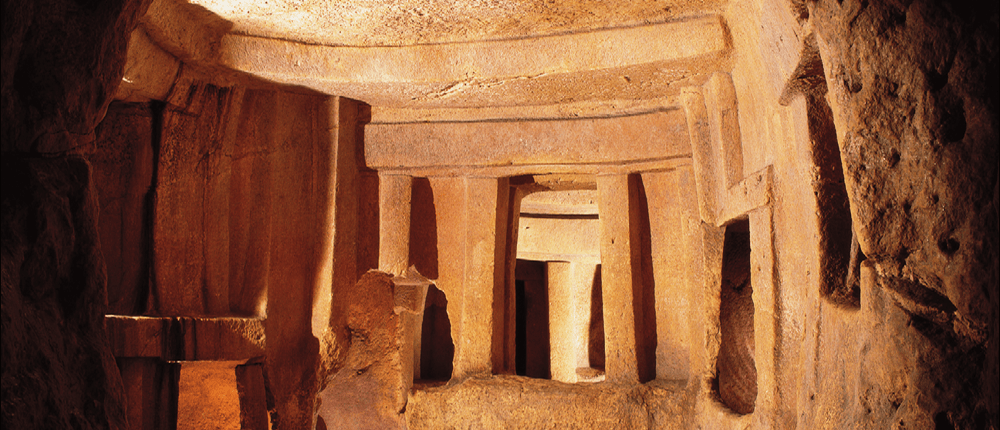The Hypogeum of Ħal-Saflieni: A Mysterious Megalithic Marvel in Malta

Hidden beneath the bustling streets of Paola, Malta, lies the Hypogeum of Ħal-Saflieni—a remarkable subterranean structure that continues to captivate archaeologists, historians, and visitors alike. This ancient site, dating back to around 4000 BCE – maybe older, is one of the most significant megalithic constructions in the world. With its enigmatic features, sophisticated engineering, and theories surrounding its purpose, the Hypogeum invites us to explore the mysteries of an ancient civilization whose identity remains shrouded in the mists of time.
An Overview of the Hypogeum

The Hypogeum is a multi-level underground complex, extending over 500 square meters. Carved entirely from limestone, it features a series of chambers, corridors, and burial sites, some reaching depths of over ten meters. The main chamber, known as the “Oracle Room,” is renowned for its stunning acoustic properties, leading to various theories about the site’s original function.
The Structure and Engineering Challenges
Building the Hypogeum was no small feat. The construction would have required immense effort and advanced techniques, particularly given the tools available at the time. The artisans who carved this subterranean labyrinth faced numerous challenges:
- Material Extraction: The limestone used in the Hypogeum was quarried from the surrounding rock, necessitating skilled labor and considerable effort to extract and shape the stones.
- Subterranean Construction: Carving a large structure underground involves significant risks, including potential collapses. The builders had to ensure the integrity of the chambers while creating a complex layout.
- Precision Engineering: The accuracy with which the chambers and passageways were hewn is remarkable. The smooth surfaces and carefully crafted features indicate a high level of craftsmanship and engineering knowledge.
The Enigmatic Features of the Hypogeum
1. Acoustic Properties
One of the most fascinating aspects of the Hypogeum is its extraordinary acoustic properties. The Oracle Room, in particular, is noted for its ability to amplify sound, creating reverberations that can be felt throughout the space. This has led to speculation that the site was used for rituals, ceremonies, or possibly even as a resonance chamber, allowing sound to play a pivotal role in spiritual practices.
2. Mysterious Artwork
The walls of the Hypogeum are adorned with intricate carvings and symbols, some of which resemble spiral motifs and other geometric shapes. The meaning behind these designs remains largely unknown, contributing to the site’s aura of mystery. These artworks may have held spiritual significance or could have been part of the burial rituals associated with the deceased interred within.
3. Burial Practices
The Hypogeum served as a burial site for the ancient inhabitants of Malta, with skeletal remains discovered throughout the complex. The burial practices observed, including the use of pottery and other grave goods, suggest a complex understanding of life and death. The sheer number of remains indicates that the site was in use for centuries, further complicating our understanding of its cultural context.
Theories of Purpose and Origin
Given the site’s unique features and construction challenges, various theories have emerged regarding its original purpose:
1. A Resonance Chamber
One of the most compelling theories posits that the Hypogeum was designed as a resonance chamber, potentially used for sound-based rituals or healing practices. The acoustic qualities of the Oracle Room, combined with the intricate carvings, suggest that sound may have held significant importance for the ancient civilization that built it. This idea raises questions about the spiritual and cultural beliefs of the people who inhabited Malta thousands of years ago.
2. An Unknown Civilization
The builders of the Hypogeum remain a mystery. While it is widely accepted that the structure was created by the ancient Maltese, some theories suggest the influence of a more advanced, unknown civilization. This idea is fueled by the sophistication of the engineering, as well as the lack of comprehensive records about the people who inhabited Malta during the Neolithic period.
The Hypogeum of Ħal-Saflieni stands as a testament to the ingenuity and artistry of an ancient civilization that left behind a legacy rich in mystery. Its impressive engineering, acoustic properties, and enigmatic features invite us to ponder the cultural and spiritual practices of its builders.
As archaeological research continues and new technologies emerge, we may yet uncover more secrets about this remarkable site. Visiting the Hypogeum is not just an exploration of an ancient structure; it’s a journey into the depths of history, sound, and the enduring human quest for meaning. The echoes of the past resonate within its chambers, reminding us of the mysteries that still await discovery.
